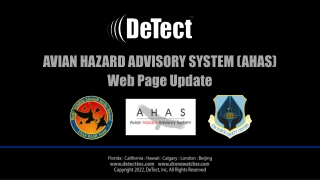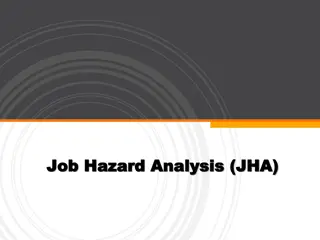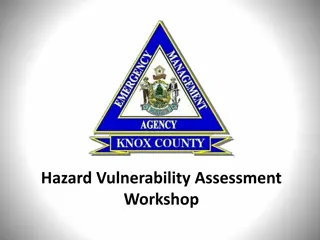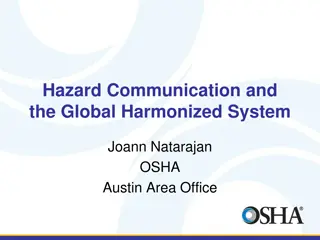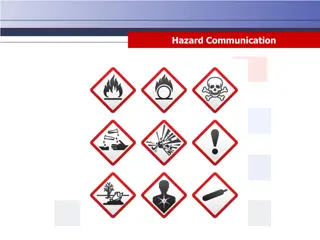Avian Hazard Advisory System (AHAS) Update
The latest updates to the Avian Hazard Advisory System (AHAS) providing crucial bird hazard information for flight safety. Learn about calculating NEXRAD risk, regional mosaics, flying areas, and risk management.
0 views • 23 slides
Chemical Safety
Dr. Anu George emphasizes the importance of developing a chemical safety plan for handling hazardous substances. The plan includes components like hazard communication, proper labeling, MSDS availability, safe storage and disposal practices, employee training, incident reporting, and record-keeping.
0 views • 43 slides
Engineering Safety and Risk Management MCQs
This content provides multiple-choice questions related to engineering safety, risk assessment, and hazard management. It covers topics such as the primary function of a Risk Assessment Matrix, engineering controls for minimizing noise pollution, the purpose of Hazard and Operability Study (HAZOP),
7 views • 21 slides
Energy Wheel & Hazard Recognition Toolbox Talk
Hazard recognition is crucial for safety in all activities. Hazards can range from gravity and motion to mechanical and chemical risks. Failure to identify hazards can lead to incidents, making tools like the Energy Wheel key for improving recognition. The Energy Wheel enhances hazard recognition by
2 views • 10 slides
Bridging the Gap Between Raw Data and Insights with Data Wrangling Tool
Organizations generate and gather enormous amounts of data from diverse sources in today's data-driven environment. This raw data, often unstructured and messy, holds immense potential for driving insights and informed decision-making. However, transforming this raw data into a usable format is a ch
0 views • 2 slides
Virginia Commonwealth University Hazard Mitigation Plan Update
The Virginia Commonwealth University (VCU) Hazard Mitigation Plan (HMP) Update Public Comment Meeting #1 took place on April 5, 2022. The meeting included introductions, overview of hazard mitigation planning, work plan details, data and information needs, next steps, and action items. Various commi
0 views • 20 slides
Safe Entry Procedures for Confined Spaces
This module covers the safe procedures for entering confined spaces, emphasizing the importance of hazard assessment, permit systems, and hazard elimination. Failure to follow safe entry procedures can result in severe consequences like fire, suffocation, poisoning, or physical harm. It guides on ho
0 views • 37 slides
Enhancing Economic Diversification in Central Africa through Leather Production
Leveraging experiences from successful comparators, particularly Ethiopia, this webinar explores skills for economic diversification in Central Africa, focusing on the leather industry. It examines livestock populations, raw hide and skin trading, animal husbandry challenges, raw hide and skin produ
0 views • 19 slides
Standardized Hazard Signage for Lab Safety
Addressing the challenge of inconsistent lab signage hindering hazard identification, our solution introduces a standardized system for hazard signs within the department. By customizing signage for individual labs and ensuring consistency and visibility, researchers and visitors can easily identify
0 views • 8 slides
Understanding Hydrogen Sulfide (H2S) Hazard Controls in Industrial Operations
Explore the systematic approach and workplace practices for managing H2S risks, including control measures, potential problem areas, well control procedures, and common types of hazard controls like engineering controls, administrative controls, and personal protective equipment.
0 views • 13 slides
Significance of Raw Materials in Food Processing
Effective selection of raw materials is crucial for ensuring the quality of processed food products. The quality of raw materials directly impacts the final products, making it important to procure materials that align closely with processing requirements. Quality evaluation, including microbiologic
2 views • 30 slides
ESHB 1817/RCW 49.80 High Hazard Facilities Stakeholder Meeting Overview
The stakeholder meeting discussed ESHB 1817 requirements for skilled and trained workforce in high hazard facilities, focusing on contractors in building and construction trades. It outlined exclusions, applicability, and exceptions to these workforce requirements. Key speakers included Maggie Lelan
0 views • 19 slides
Understanding Hazard Curves in Dam Safety Risk Assessments
This content focuses on the role of hazard curves in dam safety risk assessments, emphasizing the level of effort required for their development and the use of HEC software. It highlights the three components of risk (hazard, performance, consequence), discusses hazardous loads and potential consequ
1 views • 58 slides
Understanding Process Safety Management in Canada
This module introduces Process Safety Management (PSM) as a framework for identifying and managing process risks in the context of various engineering disciplines. The goal of PSM is to prevent major hazard incidents by proactively addressing process hazards. The content covers the principles of PSM
0 views • 34 slides
Comprehensive Risk Assessment and Hazard Mitigation Planning
This work delves into risk assessment and hazard mitigation planning supported by the National Science Foundation. It covers the importance of hazard identification, risk assessment, and mitigation planning components. Mitigation actions are outlined to reduce risks to life and property, prevent dam
2 views • 20 slides
Understanding Biosafety and Biosecurity Principles
Biosafety and Biosecurity are essential concepts in safeguarding against biological hazards. This article explores the definitions of hazard, threat, and risk, emphasizing the importance of managing risks associated with biological materials through biosafety and biosecurity measures. Learn about th
0 views • 26 slides
Importance of Job Hazard Analysis (JHA) in Workplace Safety
Job Hazard Analysis (JHA) is a crucial technique that focuses on identifying and mitigating hazards in work environments to prevent injuries, illnesses, and property damage. This analysis involves breaking down job tasks, identifying potential hazards, implementing controls, and providing necessary
0 views • 13 slides
Hazard Mitigation Assistance (HMA) Funding Eligibility and Priority
Entities within the declared disaster area have priority to apply for Hazard Mitigation Assistance (HMA) funding. Eligible applicants include those in Clackamas, Coos, Douglas, Jackson, Jefferson, Josephine, Klamath, Lake, Lane, Lincoln, Linn, Marion, Tillamook, Wasco, Washington, Yamhill Counties,
0 views • 21 slides
Factors Influencing Plant Location Selection
Plant location selection is crucial for businesses, considering factors like proximity to raw materials, transport facilities, market accessibility, labor availability, and more. An ideal location minimizes costs, maximizes market share, and ensures social gains. Other factors include climatic condi
0 views • 24 slides
Probabilistic Tsunami Hazard Assessment Project for the NEAM Region
The project, coordinated by Istituto Nazionale di Geofisica e Vulcanologia (INGV) with various partners, aims to develop a region-wide Probabilistic Tsunami Hazard Assessment (PTHA) for the North East Atlantic and Mediterranean coastlines. It involves creating PTHA database and maps, engaging intern
0 views • 10 slides
Enhancing Safety through Systematic Hazard Combinations Analysis in NPP Design Basis & PSA at NPP Paks
In this preparatory study, Tamas Siklossy, Attila Bareith, and Barnabas Toth discuss the importance of considering hazard combinations in the design basis and PSA of the Paks NPP in Hungary. The study reviews current practices, outlines technical tasks, and emphasizes the need to assess the impact o
0 views • 17 slides
Factors Affecting Manufacturing Industry Location
The location of manufacturing industries is influenced by factors such as raw materials, power supply, and availability of labor. Proximity to raw materials, access to power sources, and the labor force are crucial in determining where industries are established. Industries tend to locate near raw m
0 views • 17 slides
Declining Competition and Industrial Disruption Study
Research conducted by James Bessen, Erich Denk, Joowon Kim, and Cesare Righi focuses on the trends in competition and industrial disruption, with a specific emphasis on the hazard of displacing top firms, impacts of investments by dominant firms, and the relationship between displacement hazard, mar
0 views • 38 slides
Understanding Raw Materials in Ceramic Production
Raw materials play a crucial role in ceramic production, with three main groups identified - plastic materials like clay, non-plastic or leading mixtures such as silica, and fluxes/mineralizers like feldspar. These materials undergo various transformations during the manufacturing process, contribut
0 views • 29 slides
Raw Materials Policy of the Czech Republic: History, Modernization, and Challenges
The Raw Materials Policy of the Czech Republic has undergone significant changes and challenges throughout its history. From the approval of the previous policy in 1999 to the recent modernization efforts in 2015, political and environmental factors have played a crucial role in shaping the current
0 views • 13 slides
Virginia Commonwealth University (VCU) Hazard Mitigation Plan Update Public Forum
Virginia Commonwealth University (VCU) is updating its Hazard Mitigation Plan to address natural, human-caused, and technological threats affecting the campus. The plan aims to lessen disaster impact, assess vulnerabilities, develop mitigation strategies, and prioritize high-risk areas. VCU's rich h
0 views • 40 slides
Comprehensive Hazard Vulnerability Assessment Workshop and Tools
In this collection of images and descriptions, various aspects of Hazard Vulnerability Assessment (HVA) workshops, tools, and scoring methods are covered. Topics include risk assessment, planning policies, human factors, probability considerations, environmental and non-environmental hazard scoring,
0 views • 21 slides
Understanding Hazard Communication and the Global Harmonized System
This content discusses the changes introduced by the Global Harmonized System in Hazard Communication Standards (HCS). It highlights the impact on classifications, labels, safety data sheets, and information and training requirements. The GHS aims to enhance workplace safety by providing a standardi
0 views • 37 slides
Combining Natural Hazards with Societal Issues: Unit 1 Hazard Map Template
Delve into Unit 1 of the Hazard Map Template, identifying and locating regions susceptible to hazards by choosing top hazards in the mapping area. Create hazard maps, combine shapes, and include a key and sources for a comprehensive view of potential hazards and vulnerabilities.
0 views • 13 slides
Risk Assessment and Hazard Mitigation Overview
This document introduces risk assessment and hazard mitigation planning, supported by the National Science Foundation. It outlines the key components of risk assessment and hazard mitigation planning, emphasizing the importance of identifying and addressing the greatest risks. The process includes h
0 views • 20 slides
Importance of Hazard Communication Training for Workplace Safety
Hazard communication training is essential for creating a safe work environment by helping individuals recognize and manage hazardous materials effectively. Understanding the Globally Harmonized System (GHS) and following hazard communication laws can improve workplace safety, protect human health,
0 views • 36 slides
Hazard Communication Training and Safety Data Sheets Overview
This resource provides detailed information on hazard communication training, safety data sheets (SDS), GHS format elements, HMIS and NFPA labeling systems, GHS symbols, and building safety precautions. It covers essential aspects such as hazard identification, SDS requirements, chemical labeling, G
0 views • 39 slides
Engineering Seismology & Seismic Hazard Assessment Lectures Overview
This content provides detailed information on the Rose School Lectures 2013 by Sinan Akkar and D. M. Boore focusing on Engineering Seismology & Seismic Hazard Assessment. It includes course schedules, instructor details, contact information, and online software used. Topics covered range from hazard
0 views • 10 slides
Global Harmonized System of Classification and Labeling of Chemicals (GHS) Overview
The Global Harmonized System of Classification and Labeling of Chemicals (GHS) was developed to address the inconsistencies in hazard information for chemicals globally due to significant trade. The history, mandate, and provisions of GHS, along with additional domestic harmonization efforts, are di
0 views • 29 slides
Statistical Modelling of Hazard Frequency and Magnitude in External Events
Dr. Curtis Smith from Idaho National Laboratory presented a benchmark on External Events Hazard Frequency and Magnitude Statistical Modelling. The background involves the Working Group on External Hazards (WGEV) addressing the challenges in formulating and assessing external event initiating events
0 views • 11 slides
Hazard Communication in the Workplace
Employers must gather information on the hazards of chemicals they use and communicate this information to workers through training, labeling, and access to Safety Data Sheets (SDSs) as per OSHA Hazard Communication Standard (1910.1200). Hazard Communication Program (HCP) training covers chemical ex
0 views • 20 slides
Raw Elements Substitution in Electronic and Optoelectronic Technologies Overview
Explore the advancements in raw elements substitution in electronic and optoelectronic technologies led by Pier Carlo Ricci from the University of Cagliari, focusing on key applications, research areas, and industry impacts. The project, coordinated by RESET, aims to enhance sustainability and innov
0 views • 12 slides
Raw Materials in Industrial Fermentation Processes
Microorganisms utilized in industrial fermentation require essential raw materials such as water, energy sources, carbon, nitrogen, mineral elements, and sometimes vitamins and oxygen. Various raw materials like cane molasses, beet molasses, cereal grains, starch, glucose, and lactose serve as carbo
0 views • 15 slides
Understanding Survival Analysis: Hazard Function and Cox Regression
Survival analysis examines hazards, such as the risk of events occurring over time. The Hazard Function and Cox Regression are essential concepts in this field. The Hazard Function assesses the risk of an event in a short time interval, while Cox Regression, named after Sir David Cox, estimates the
0 views • 20 slides
Mitigating California Wildfires: Hazard Mitigation Grant Program Overview
The Hazard Mitigation Grant Program (HMGP) aims to reduce loss of life and property from future disasters by implementing long-term risk reduction strategies. The program focuses on creating or updating Local Hazard Mitigation Plans, prioritizing post-wildfire mitigation activities, including soil s
0 views • 18 slides
